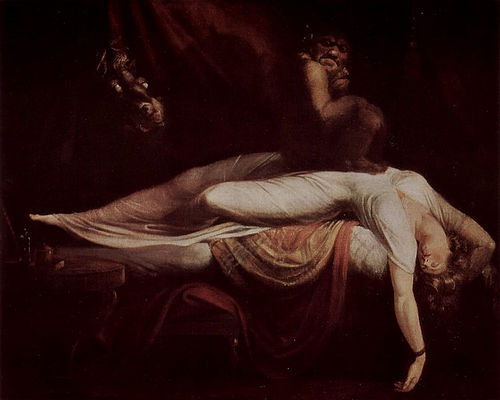“No dancer can watch Fred Astaire and not know that we all should have been in another business.” — Mikhail Baryshnikov
Wheels Within Wheels

An optical illusion. Move your nose toward the dot in the center.
Platinum Plus
All-time best-selling music artists:
- The Beatles (about 1 billion albums sold)
- Elvis Presley (500 million)
- ABBA (350 million)
- Led Zeppelin (320 million)
- Alla Pugacheva (250 million)
- Cliff Richard (260 million)
- Julio Iglesias (250 million)
- Nana Mouskouri (250 million)
- Madonna (250 million)
- Michael Jackson (250 million)
Alla Pugacheva is a Russian popular singer active since 1965. Greece’s Nana Mouskouri has been singing even longer — since 1961. Her French record company recently released a box set of 34 CDs.
Please RSVP
“ATM machine” is an example of a redundant acronym — the M already stands for machine, so this phrase means “automatic teller machine machine.” Other examples:
- PIN number = personal identification number number
- GUI interface = graphical user interface interface
- ISBN number = International Standard Book Number number
- SAM missile = surface-to-air missile missile
- LCD display = liquid crystal display display
- CRT tube = cathode-ray tube tube
- HIV virus = human immunodeficiency virus virus
- SCSI interface = Small Computer System Interface interface
- AC current = alternating current current
- RPG games = role-playing games games
This goes for people, too. Jeb Bush’s nickname derives from his initials (J.E.B., for John Ellis Bush). So “J.E.B. Bush” stands for “John Ellis Bush Bush”.
Great Wall From Space

The Great Wall of China, as seen from the space shuttle. Contrary to popular belief, an unaided viewer cannot see it from the moon. One shuttle astronaut said, “We can see things as small as airport runways, [but] the Great Wall is almost invisible from only 180 miles up.” An Apollo astronaut said no human structures were visible at a distance of a few thousand miles. And — most tellingly — Chinese astronaut Yang Liwei couldn’t see it at all.
Or Best Offer
Unusual items sold on eBay:
- The right to permanently tattoo an ad on a woman’s forehead (sold to GoldenPalace.com for $10,000)
- A Volkswagen Golf that had previously been registered to Josef Kardinal Ratzinger (now Pope Benedict XVI) (sold on eBay’s German site for €188,938.88)
- The first ride on Kingda Ka, the tallest roller coaster on Earth ($1,691.66)
- A piece of Nutri-Grain resembling E.T. ($1,035 Australian)
- A 50,000-year-old mammoth weighing 250,000 kilos (£61,000)
Unsold: a 16-year-old’s virginity and a half-eaten grilled-cheese sandwich.
Elbow Room
The world’s population reached:
- 1 billion in 1802
- 2 billion in 1927
- 3 billion in 1961
- 4 billion in 1974
- 5 billion in 1987
- 6 billion in 1999
According to the United Nations Population Fund, the 6 billionth baby was born at 12:02 a.m. on Oct. 12, 1999, to Fatima Nevic and her husband, Jasminko, in Sarajevo, Bosnia.
The forecast, according to the U.N.’s World Population Prospects database:
- 2010: 6.8 billion
- 2020: 7.6 billion
- 2030: 8.2 billion
- 2040: 8.7 billion
- 2050: 9.1 billion
Better get started early on that Christmas shopping.
Mare Rides

Folk remedies to prevent nightmares:
- Stop up the keyhole, place your shoes with the toes facing the door, then get into bed backward.
- Put something made from steel, such as an old pair of scissors, in your bedstraw.
- Urinate into a clean, new bottle, hang the bottle in the sun for three days, carry it — without saying a word — to a running stream, and throw it over your head into the stream.
Or take a small child free of sin, soak it in a bath for a couple of hours, then dry it on a goat or a sheep. The next night, sleep with the naked baby in your bed and you’ll never have nightmares again.
“Because He Left a Residue at Every Pole”
Incomprehensible math jokes:
Q: What is lavender and commutes?
A: An Abelian semigrape.
Q: What’s yellow, linear, normed, and complete?
A: A Bananach space.
Q: What’s the value of a contour integral around Western Europe?
A: Zero, because all the Poles are in Eastern Europe.
Q: What do you get when you cross a mountain climber with a mosquito?
A. Nothing: you can’t cross a scaler with a vector.
Q: What’s hot, chunky, and acts on a polygon?
A: Dihedral soup.
Q: What sound does a drowning analytic number theorist make?
A: “Log log log log …”
Q: What’s sour, yellow, and equivalent to the axiom of choice?
A: Zorn’s lemon.
“Mathematicians are like Frenchmen,” wrote Goethe. “Whatever you say to them they translate into their own language, and forthwith it is something entirely different.”
Nimrod, Minnesota

Unfortunate place names:
- Accident, Maryland
- Big Ugly Wilderness Area, West Virginia
- Difficult, Tennessee
- Effort, Pennsylvania
- Foulness, Essex, England
- Hell For Certain, Kentucky
- Hole in the Ground, Oregon
- Nothing, Arizona
- Pity Me, County Durham, England
- Toadsuck, Texas
Niemyje-Zabki, Poland, means “He is not cleaning his teeth.”
